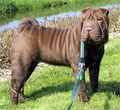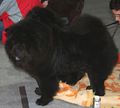Difference between revisions of "Hiatal Hernia"
BaraStudent (talk | contribs) |
JamesSwann (talk | contribs) |
||
| (26 intermediate revisions by 5 users not shown) | |||
| Line 1: | Line 1: | ||
| − | {{ | + | {{review}} |
| − | |||
| − | |||
| − | |||
| − | |||
| − | + | {{dog}} | |
| − | + | ==Typical Signalment== | |
| + | Dogs that are predisposed to this disorder include: | ||
| − | + | <gallery> | |
| + | Image:Shar_pei.jpg|'''Shar Pei'''<p>WikiCommons | ||
| + | Image:Chow_chow.jpg|'''Chow Chow'''<p>WikiCommons | ||
| + | Image:Bulldog.jpg|'''Bulldog'''<p>WikiCommons | ||
| + | Image:French_bulldog.jpg|'''French Bulldog'''<p>WikiCommons | ||
| + | </gallery> | ||
| − | == | + | ==Description== |
| − | + | A hiatal hernia is a diaphragmatic abnormality that allows part of the stomach and the abdominal oesophagus to prolapse into the thoracic cavity. | |
| − | + | Two types of hiatal hernia have been recognized in the dog and cat: | |
| − | ''' | + | *'''Sliding hiatal hernia''' - Cranial displacement of the distal oesophagus and stomach into mediastinum through the oesophageal hiatus.This is the most common form. It can occur in the dog and cat and may occur as a congenital or acquired lesion. Congenital hernias result from incomplete fusion of the diaphragm during early embryonic development. |
| − | ''' | + | *'''Para-oesophageal hiatal hernia''' - Cranial displacement of part of the stomach into mediastinum through a defect ''adjacent'' to the oesophageal hiatus. |
| − | + | Acquired hernias can occur in any breed of dog or cat. The cause is unknown but it is suspected to result from disorders that cause increases in intra-abdominal pressure (ie chronic vomiting) or increases in negative intrathoracic pressure (ie intermittent airway obstruction seen with [[Laryngeal Paralysis - Canine|laryngeal paralysis]]). | |
| − | + | ==Diagnosis== | |
| + | ===Clinical Signs=== | ||
| + | Some animals may be asymptomatic but otherwise clinical signs include: | ||
| + | *regurgitation | ||
| + | *vomiting | ||
| + | *hypersalivation | ||
| + | *dyspnoea | ||
| + | *coughing | ||
| + | *dehydration | ||
| + | *weight loss | ||
===Diagnostic Imaging=== | ===Diagnostic Imaging=== | ||
| − | '''Plain survey radiographs''' may | + | *'''Plain survey radiographs''' may visualise a caudodorsal gas-filled intrathoracic soft tissue opacity which is diagnostic of a hiatal hernia.Oesophageal dilatation and alveolar consolidation may be present with aspiration pneumonia. |
| − | + | *'''Barium contrast studies''' may be used to confirm a diagnosis. | |
| − | + | Intermittent hiatal hernias can be difficult to detect and therefore it is sometimes necessary to put pressure on the abdomen during the radiography procedure to induce displacement of the stomach. | |
| − | '''Endoscopy''' may demonstrate cranial displacement of the | + | *'''Fluoroscopy''' can be used to assess for intermittent herniation if a hiatal hernia is suspected by the survey radiographs. |
| + | *'''Endoscopy''' may demonstrate cranial displacement of the caudal oesophageal sphincter and a large oesophageal hiatus. | ||
==Treatment== | ==Treatment== | ||
| − | |||
| − | + | '''Medical therapy''' should be attempted first: | |
| + | *[[Gastroprotective Drugs]] | ||
| + | **oral sucralfate | ||
| + | **gastric acid secretory inhibitors (cimetidine, ranitidine, omeprazole) | ||
| + | *increase tone of caudal oesophageal sphincter (metoclopramide) | ||
| − | + | '''Surgical therapy''' is usually attempted with congenital cases : | |
| − | + | *laryngeal surgery if [[Laryngeal Paralysis - Canine|laryngeal paralysis]] has contributed to the hernia. | |
| − | + | *diaphragmatic crural apposition, oesophagopexy and gastropexy. | |
| − | + | *tube gastropexy with cases with severe oesophagitis or ulceration. | |
| − | |||
| − | |||
| − | |||
| − | |||
| − | |||
| − | |||
| − | |||
| − | |||
==Prognosis== | ==Prognosis== | ||
| − | Prognosis is good after surgical repair or aggressive medical management | + | Prognosis is good after surgical repair or aggressive medical management. |
| − | |||
| − | |||
| − | |||
| − | |||
| − | |||
| − | |||
| − | |||
==References== | ==References== | ||
| − | |||
| − | |||
| − | |||
| − | |||
| − | |||
| − | |||
| − | + | *Hall, E.J, Simpson, J.W. and Williams, D.A. (2005) '''BSAVA Manual of Canine and Feline Gastroenterology (2nd Edition)''' ''BSAVA'' | |
| + | *Nelson, R.W. and Couto, C.G. (2009) '''Small Animal Internal Medicine (Fourth Edition)''' ''Mosby Elsevier'' | ||
[[Category:Oesophagus_-_Pathology]] | [[Category:Oesophagus_-_Pathology]] | ||
| − | [[Category: | + | [[Category:To_Do_-_James]] |
| − | |||
| − | |||
| − | |||
| − | |||
| − | |||
Revision as of 10:04, 6 July 2010
| This article has been peer reviewed but is awaiting expert review. If you would like to help with this, please see more information about expert reviewing. |
Typical Signalment
Dogs that are predisposed to this disorder include:
Description
A hiatal hernia is a diaphragmatic abnormality that allows part of the stomach and the abdominal oesophagus to prolapse into the thoracic cavity. Two types of hiatal hernia have been recognized in the dog and cat:
- Sliding hiatal hernia - Cranial displacement of the distal oesophagus and stomach into mediastinum through the oesophageal hiatus.This is the most common form. It can occur in the dog and cat and may occur as a congenital or acquired lesion. Congenital hernias result from incomplete fusion of the diaphragm during early embryonic development.
- Para-oesophageal hiatal hernia - Cranial displacement of part of the stomach into mediastinum through a defect adjacent to the oesophageal hiatus.
Acquired hernias can occur in any breed of dog or cat. The cause is unknown but it is suspected to result from disorders that cause increases in intra-abdominal pressure (ie chronic vomiting) or increases in negative intrathoracic pressure (ie intermittent airway obstruction seen with laryngeal paralysis).
Diagnosis
Clinical Signs
Some animals may be asymptomatic but otherwise clinical signs include:
- regurgitation
- vomiting
- hypersalivation
- dyspnoea
- coughing
- dehydration
- weight loss
Diagnostic Imaging
- Plain survey radiographs may visualise a caudodorsal gas-filled intrathoracic soft tissue opacity which is diagnostic of a hiatal hernia.Oesophageal dilatation and alveolar consolidation may be present with aspiration pneumonia.
- Barium contrast studies may be used to confirm a diagnosis.
Intermittent hiatal hernias can be difficult to detect and therefore it is sometimes necessary to put pressure on the abdomen during the radiography procedure to induce displacement of the stomach.
- Fluoroscopy can be used to assess for intermittent herniation if a hiatal hernia is suspected by the survey radiographs.
- Endoscopy may demonstrate cranial displacement of the caudal oesophageal sphincter and a large oesophageal hiatus.
Treatment
Medical therapy should be attempted first:
- Gastroprotective Drugs
- oral sucralfate
- gastric acid secretory inhibitors (cimetidine, ranitidine, omeprazole)
- increase tone of caudal oesophageal sphincter (metoclopramide)
Surgical therapy is usually attempted with congenital cases :
- laryngeal surgery if laryngeal paralysis has contributed to the hernia.
- diaphragmatic crural apposition, oesophagopexy and gastropexy.
- tube gastropexy with cases with severe oesophagitis or ulceration.
Prognosis
Prognosis is good after surgical repair or aggressive medical management.
References
- Hall, E.J, Simpson, J.W. and Williams, D.A. (2005) BSAVA Manual of Canine and Feline Gastroenterology (2nd Edition) BSAVA
- Nelson, R.W. and Couto, C.G. (2009) Small Animal Internal Medicine (Fourth Edition) Mosby Elsevier



